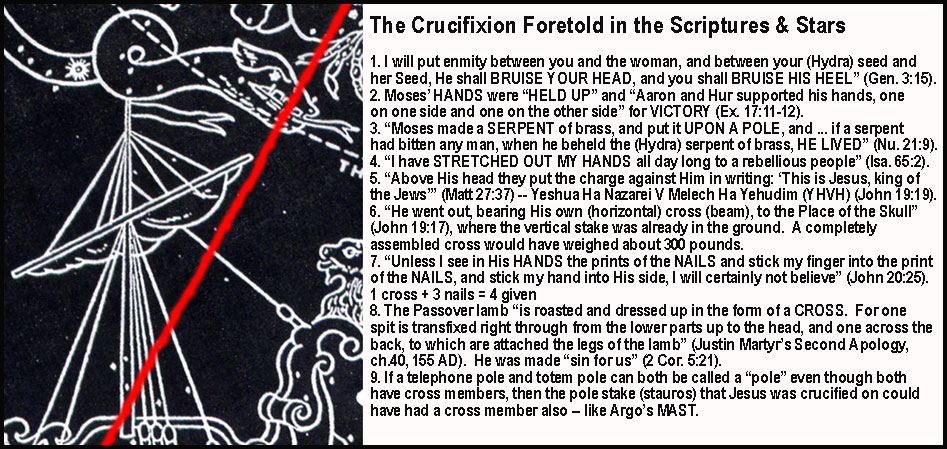
Is the CROSS A Pagan Symbol?
A CROSS Found in the Old Testament?
Exodus 17:11-12 says Moses STRETCHED OUT HIS HANDS, in imitation of Christ's sacrifice on the CROSS, so that Israel was victorious over Amalek. He was between two other men.
Numbers 21:9 says "Moses made a serpent of brass, and put it upon a POLE" to heal Israel indicating the CRUCIFIXION of Christ." (John 3:14) Do we know what that POLE looked like? Did it look like a MAST? See the illustration above.
Ezekiel 9:4 says, "Go through the midst of the city, through the midst of Jerusalem: and mark THAU upon the foreheads of the men that sigh, and mourn for all the abominations that are committed in the midst thereof." (Douay-Rheims)

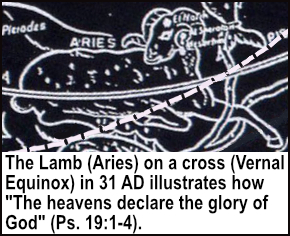
In Hebrew, the last letter in the Jewish alphabet is called "Tav". Originally the Tav looked like a CROSS, but over the centuries the handwritten character changed to its present form. Specifically, around 2,000 BC the letter was shaped like St. George’s Cross (+). Around 1,000 BC—a few hundred years before the writing of Ezekiel—it still had a cross-shape but was more like St. Andrew’s Cross (X). The word "Tav" literally means "mark" in Hebrew. These people of Ezekiel 9:4 were designated as FAITHFUL to the Lord. The mark, probably a Tav or CROSS sign, in this instance puts its wearer under God's protection for deliverance from a fate that will strike the unmarked. The use of this sign may have originated with the first Passover when, according to tradition, the Israelites put lamb's blood on their door frames in the form of a Tav CROSS. Thus the angel of God destroyed the first born of the Egyptians but "passed over" the houses of the Israelites (Exodus 12). Christ's sacrifice on the CROSS cleanses us from all sin.
Was Jesus Crucified on a CROSS or Stake?
The association of the LAMB with the CROSS around the time of Passover (31 AD) corresponded to ARIES being on the heavenly CROSS of Ecliptic and Equator at the time of the equinox (31 AD). That seems to be more than a coincidence. Because of Earth's axial precession (the slow wobble of Earth's axis), the vernal equinox is no longer in Aries, but in the neighbouring Pisces. However, in 130 BCE, it was located just south of Gamma Arietis (Mesarthim) and was taken to be the starting point of the zodiac. Due to Earth's axial precession, this point gradually moves westwards at a rate of about one degree every 72 years. This means that, since the time of Hipparchus, it has shifted across the sky by about 30°, and is currently located within Pisces, near its border with Aquarius. As the Bible says, "The heavens declare the glory of God; and the firmament sheweth his handywork. Day unto day uttereth speech, and night unto night sheweth knowledge. There is no speech nor language, where their voice is not heard. Their line is gone out through all the earth, and their words to the end of the world. In them hath he set a tabernacle for the sun" (Ps. 19:1-4).
Jesus gave Peter a glimpse of the manner of his death: “‘When you are old you will STRETCH OUT your HANDS, and someone else will dress you and lead you where you do not want to go.’ Jesus said this to indicate the kind of death by which Peter would glorify God” (John 21:18–19). The fact that Peter (who tradition says was CRUCIFIED) would “STRETCH OUT” his hands indicates that Roman CRUCIFIXION usually involved OUTSPREAD ARMS such as would be positioned on a CROSS BEAM.
The other clue that Jesus was CRUCIFIED on a CROSS is found in John 20. Thomas, in his famous moment of doubt, said, “Unless I see the nail marks in his hands and put my finger where the NAILS were, and put my hand into his side, I will not believe” (verse 25). Note Thomas’s mention of the NAILS (plural) that had scarred Jesus’ hands. If Jesus had been CRUCIFIED on a stake or a pole, only ONE NAIL would have been used. The fact of TWO NAILS in the hands suggests a traditional cross.
Completely lost in arguments over the shape of the cross is its significance to us. Jesus said, “If anyone would come after me, he must deny himself and take up his cross and follow me. For whoever wants to save his life will lose it, but whoever loses his life for me will find it” (Matthew 16:24–25). The cross/stake/pole was an instrument of death. By telling us to take up our cross and follow Him, Jesus says that, in order to be His true followers, we must die to self. If we call ourselves “Christians,” then we must deny ourselves and give up our lives for His sake. This may take the extreme form of being martyred for our faith, but even in the most peaceful political settings, we must be willing to lose the self—crucifying self-righteousness, self-promotion, selfish ambitions—in order to be His followers. Those who are not willing to do so are “not worthy” of Him (Matthew 10:38).
W. E. Vine's Expository Dictionary of New Testament Words states that the primary meaning of STAUROS was an upright pale or stake on which malefactors were nailed for execution. Vine said the shape of the ecclesiastical form of two-beamed cross had its origin in ancient Chaldea, and was used as the symbol of the god Tammuz (taking on the shape of the mystic Tau, the initial of his name) in Chaldea and nearby lands, including Egypt. He said third century churches, which by then had departed from certain doctrines of the Christian faith, accepted pagans into the faith in order to increase their prestige and allowed them to retain their pagan signs and symbols. "Hence the Tau or T, in its most frequent form, with the cross-piece lowered, was adopted to stand for the 'cross' of Christ." ("Cross, Crucify")
However, other reference works contend that STAUROS (of the Gospel accounts) was "a post with a CROSS-BEAM" (Theological Dictionary of the New Testament), [p.1071] "the form usually seen in pictures, the crux immissa (Latin cross †), ... in which the upright beam projects above the shorter CROSSPIECE" (International Standard Bible Encyclopedia); [A-D, p.826] and "most likely the crux immissa (the traditional † depiction) or the crux commissa (a T-shaped cross)" (John R. Donahue and Daniel J. Harrington, The Gospel of Mark). Donahue and Harrington suggest: "The victim was first affixed to the CROSSBEAM (patibulum) with ropes and/or nails through the wrists or forearms. Then the CROSSBEAM was fitted on the vertical beam and the victim was lifted up and set on a peg or "seat" on the vertical beam and perhaps also on a footrest. The idea was to prolong the agony, not to make the victim more comfortable." [p.442]
Dionysius of Halicarnassus, who lived at the time of the birth of Jesus, described how those condemned to crucifixion were led to the place of execution:
"A Roman citizen of no obscure station, having ordered one of his slaves to be put to death, delivered him to his fellow-slaves to be led away, and in order that his punishment might be witnessed by all, directed them to drag him through the Forum and every other conspicuous part of the city as they whipped him, and that he should go ahead of the procession which the Romans were at that time conducting in honour of the god. The men ordered to lead the slave to his punishment, having STRETCHED OUT both his ARMS and FASTENED THEM to a PIECE of WOOD which EXTENDED ACROSS his BREAST and SHOULDERS as far as his wrists, followed him, tearing his naked body with whips." [Roman Antiquities, VII, 69:1-2]
Christians of the first centuries are unanimous in describing the particular structure on which Jesus died as having a CROSS BEAM, not as a simple upright STAKE.
For instance, Justin Martyr (100–165) explicitly says the cross of Christ was of TWO-BEAM shape: "That lamb which was commanded to be wholly roasted was a symbol of the suffering of the cross which Christ would undergo. For the lamb, which is roasted, is roasted and dressed up in the form of the CROSS. For one spit is transfixed right through from the lower parts up to the head, and ONE ACROSS THE BACK, to which are ATTACHED the LEGS of the lamb." [Dialogue with Trypho XL]
Justin also saw the stretched-out hands of Moses in the battle against Amalek as foreshadowing the cross of Jesus: "If he gave up any part of this sign, which was an imitation of the CROSS, the people were beaten, as is recorded in the writings of Moses; but if he remained in this form, Amalek was proportionally defeated, and he who prevailed prevailed by the CROSS. For it was not because Moses so prayed that the people were stronger, but because, while one who bore the name of Jesus (Joshua) was in the forefront of the battle, he himself made the SIGN of the CROSS." [Dialogue with Tryphon 90:4]
In his First Apology, 55 Justin refers to various objects as shaped like the cross of Christ: "The sea is not traversed except that trophy which is called a SAIL abide safe in the ship ... and this shows no other form than that of the CROSS."
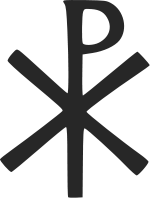
In This Sign Conquer -- Chi-Rho -- The Sign of the Son of Man in Heaven
On 28 October 312 AD, at the Battle of the Milvian Bridge, Constantine was victorious. According to Lactantius, Constantine was visited by a dream the night before the battle, wherein he was advised "to mark the heavenly sign of God on the shields of his soldiers ... by means of a slanted letter X with the top of its head bent round, he marked Christ on their shields."[De Mortibus Persecutorum 44.4–6] Eusebius describes another version, where, while marching at midday, "he saw with his own eyes in the heavens a trophy of the CROSS arising from the light of the sun, carrying the message, In Hoc Signo Vinces or "with this sign, you will conquer" [Vita Constantini 1.28]; in Eusebius's account, Constantine had a dream the following night, in which Christ appeared with the same heavenly sign, and told him to make a standard, the LABARUM, for his army in that form [Vita Constantini 1.27–29]. Eusebius is vague about when and where these events took place, but it enters his narrative before the war against Maxentius begins. Eusebius describes the sign as Chi (Χ) traversed by Rho (Ρ): a symbol representing the first two letters of the Greek spelling of the word Christos or Christ. As Psalm 20:5 says, "In the name of the Lord we will display our banners" or shields which must have encouraged the Christian soldiers in Constantine's army. In 315 AD a medallion was issued at Ticinum showing Constantine wearing a helmet emblazoned with the Chi Rho. Later, God gave Constantine a vision of a CROSS with the words "In this sign conquer."
The Greek letter "Chi" (X) was recognized as an equivalent of the Tav. The early Christians saw a double meaning in this initial representing Jesus and usually combined it with the Greek letter "Rho" (P) as a monogram or insignia in their inscriptions.
The Chi-Rho cross is a little unique among the forms of the cross because it is the so-called “monogram of Christ” being the first two letters of the Greek word for Christ. It is also called the Labarum in some works.
After Constantine had the "vision of the cross," he promoted another variety of the cross, the Chi-Rho or Labarum. This has been explained as representing the first letters of the name Christos (CH and R, or, in Greek, X and P). The identical symbols were found as inscriptions on rock, dating from ca. 2500 B.C., being interpreted as "a combination of the two Sun-symbols."
The Chi-Rho is an ancient symbol, used millenia before Christ. A few centuries before Christ, it was used by Egyptian King Ptolemy III, who reigned from 246 to 222 B.C. According to An Illustrated Encyclopedia of Traditional Symbols, the labarum was also an emblem of the Chaldean sky-god. Emperor Constantine adopted the labarum as the imperial ensign. According to Dictionary of Mythology Folklore and Symbols, the symbol was in use long before Christianity. Chi probably stood for Great Fire or Sun. Rho probably stood for Pater or Patah (Father). The word labarum yields "everlasting Father Sun."
“The Chi-Rho, as a symbol, was in use long before Biblical Christianity entered the scene. The ‘X’ (Chi) represented the Great Fire or Sun and the P (Rho) was for Patah or Pater (Father)…. It is a composition of X and P (Chi and Rho), which means ‘Sun’ or ‘Fire’ and ‘Father’, rendering, ‘Father Sun’ or ‘Great Father Sun’."
The Chi Rho cross was a pre-Christian symbol, the name and meaning of which points to a pagan sun-god! It was used by several solar deities as their symbol, but specifically, the Babylonians used it as an emblem of their sky-god, as Cooper states: “The labarum was also an emblem of the Chaldean (Babylonian) sky-god and in Christianity it was adopted…” (Cooper, An Illustrated Encyclopedia of Traditional Symbols. 1987.)
Egyptologist Sir Flinders Petrie said that the Chi-Rho was the emblem of the Egyptian god Horus thousands of years before Christ.
“An identical symbol to the Chi-Rho has been found inscribed on rocks dating from 2,500 B.C. Sumeria, and was interpreted as ‘a combination of the two Sun-symbols’ – symbols of the ancient shining ones.” (Gardiner “The Skull and Crossbones: The Untold Story of the Templar Shining Ones.”)
The Chi-Rho, despite what people claim, has been used thousands of years before Christ to honor sun-gods of many cultures. It has been used to signify “good fortune”, and interestingly, before its adoption by Christianity, it was known as the monogram of Chronos! NOT the monogram of Christ!
“Before it became the monogram of Christ, the Chi Rho was the monogram of Chronos (whose name also begins with a Chi-Rho in the Greek spelling), the god of time, and an emblem of several solar deities…. The Chi Rho was used in hermetic alchemical texts to denote time.” (Emick “Chi-Rho”).
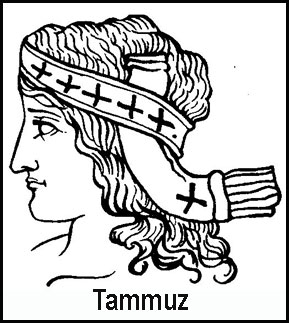
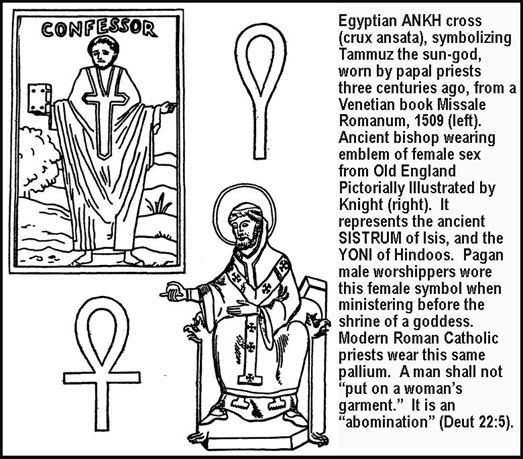
Should We Use the CROSS in Worship?
To prevent the BODY of MOSES from being worshipped, it was taken and buried in secret (Deut. 34:6; Jude 9). To prevent the BRASS SERPENT from being worshipped, it was destroyed (2 Ki. 18:4). To prevent idolatry of CROSS-worship, we as Christians should destroy them. We should not hang CROSSES around our necks. They should not be found in churches. The cross was an instrument of death which took our Lord's life.
The story of the cross as a religious symbol begins in ancient Babylon. Upon Nimrod's death, his wife Semiramis exalted her infant son, Tammuz, as Nimrod re-born. God-king worship became quickly entrenched among the ancient Babylonians…and the Tau symbol – the first letter of Tammuz' name became a key symbol in Babylonian worship.
"The well-known T-shaped cross was in use in pagan lands long before Christianity, as a representation of the male member, and also at the same time of the 'tree' on which the god (Attis or Adonis or Krishna or whoever it might be) was crucified; and the same symbol combined with the oval (or yoni) formed the Crux Ansata of the old Egyptian ritual -- a figure which is today sold in Cairo as a potent charm, and confessedly indicates the conjunction of the two sexes in one design." (p.183, The Origins of Pagan and Christian Beliefs by Edward Carpenter)
The Tau was an integral part of pagan religious worship in pre-Christian culture. The cross was sewn into pagan priests' costumes, worn by vestal virgins, and adorned pagan temples. (See, Alexander Hislop's: The Two Babylons and The Catholic Encyclopedia, "The Cross and Crucifix," page 517, 1913 edition). The Tau took various forms such as Τ and t and would sometimes incorporate a circle representing the sun – an integral part of the Babylonian Mystery Religion.
That mystic Tau was marked in baptism on the foreheads of those initiated in the Mysteries (Tertullian De Praescript. Haeret. cap.40 vol.2, p.54). Layard identified the CROSS with the SUN (Nineveh and Babylon p. 211). The Tau was used as an amulet over the heart (Wilkinson John Gardiner. Manners and Customs of the Ancient Egyptians. First Series. vol.1, p.365). It was marked on the official garments of the pagan priests; it was carried by kings in their hand, as a token of their dignity or authority. Vestal virgins of pagan Rome wore it suspended from their necklaces as the nuns do today (Pere Lafitan, Moeurs des Sauvages Ameriquains, vol.1, p.442). The CROSS was suspended from a necklace in the 15th century BC (Wilkinson, vol.1, p.376).
After his death, Nimrod was worshipped under various names including Marduk, Bel, Baal and Beelzebub. Baal-worship, a continuation of Babylonian religion, was what God rebuked ancient Israel for when they "did evil in the sight of the LORD. They forgot the LORD their God, and served the Baals and Asherahs" (Judges 3:7).
But Nimrod worship spread throughout the ancient world. Nimrod-reborn as Tammuz was associated with the Tau symbol in the pre-Christian, pagan worship of the ancient Babylonians, Orientals, Philistines, Egyptians. It crept into what became the Roman Catholic Church and then was adopted by the various Protestant denominations. The pagan Tau now adorns most church buildings and priestly costumes – just as it did in the ancient, pagan world! But it never adorned Christ, the apostles or Christians.
"Mithratic...initiates...would henceforth have the Sun CROSS on their foreheads. The similarity to the CROSS of ashes made on the forehead on the Christian Ash Wednesday is striking. Some have suggested this to be an example of the early Christians borrowing from the Mithratic cult; others suggest that both cults were drawing upon the same prototype (Nabarz P. The mysteries of Mithras: the pagan belief that shaped the Christian world. Inner Traditions / Bear & Company, 2005, p. 36).
"Candidates who successfully passed the Mithraic initiations were called Lions and were marked upon their foreheads with the Egyptian CROSS." (Manly P. Hall (Author), J. Augustus Knapp (Illustrator) The Secret Teachings of all Ages. Originally published 1926, reprint Wilder Publications, 2009, p. 45)
| Mark of the Beast |
"And he causeth all, both small and great, rich and poor, free and bond, to receive a mark (cross) in their right hand, or in their foreheads: And that no man might buy or sell, save he that had the mark, or the name of the beast (Latin Kingdom), or the number of his name. Here is wisdom. Let him that hath understanding count the number of the beast (Latin Kingdom): for it is the number of a man (Lateinos); and his number is Six hundred threescore and six" (13:16-18) (666). "If anyone worships the beast (Latin Kingdom) and his image (Papacy), and receives his mark (cross) on his forehead or on his hand, he too will drink the wine of God’s anger, poured undiluted into the cup of His wrath. And he will be tormented in fire and sulfur in the presence of the holy angels and of the Lamb" (Rev. 14:9-10).
The MARK of the cross is put on the FOREHEADS of all baptised in the Roman faith; and on the HANDS of all who become priests and monks. "The Sacrament of Confirmation is also known by the name of Chrism, because the FOREHEAD of the person confirmed is anointed with chrism in the form of a CROSS" (Faith of Our Fathers by James Cardinal Gibbons, 1897, p.320). The priest "draws with his right hand the sign of the CROSS upon the HANDS of him whom he ordains" (Roman Catholic Rubric). On Ash Wednesday, the first day of Lent, Catholics put the Latin CROSS on their FOREHEADS in oil and ashes.
To argue that this heathen symbol "is now okay to use and honor in worship because the meaning now points to Christ," ignores the fact that Jesus Christ and the apostles and the original New Testament Church never worshipped or revered the CROSS (they saw it for what it was – a pagan symbol and a cruel instrument of death), but is also to ignore the words of Jeremiah the prophet – "Thus saith the LORD, Learn not the way of the heathen" (Jeremiah 10:2, KJV).
While human memory is short, and most simply do not understand the pagan history of the CROSS, the Almighty God does remember where the symbol came from! He remembers the cry of burning infants sacrificed to Baal (Ezekiel 16:20-21)! He remembers the cruel instrument of crucifixion upon which many died, even including His Son.
“The CROSS was widely known in pre-Christian times as an emblem that was a well-known Heathen Sign.” (Unger’s Bible Dictionary)
Would God want you to use this “well-known heathen sign” to remember Him? This symbol that commemorates Tammuz, Chronos, Bacchus, and other sun-gods?
He says, "take care that you do not go in their ways, and that you do not give thought to their gods, saying, How did these nations give worship to their gods? I will do as they did. Do not so to the Lord your God: for everything which is disgusting to the Lord and hated by him they have done in honour of their gods: even burning their sons and daughters in the fire to their gods." (Deut. 12:30-31; Jeremiah 10:2-5; Exodus 23:24; Deuteronomy 12:1-4
God said NOT to do as the heathen do! He wants people to worship Him in a DIFFERENT way! He commanded you NOT to learn the way of the heathen (Jeremiah 10:2), but instead to LEARN the difference between the holy and the unholy, between the clean and the unclean, between Him and false gods!
"And they [the priests] are to make clear to my people the division between what is holy and what is common, and to give them the knowledge of what is clean and what is unclean." (Ezekiel 44:23)
Augustine of Hippo (a Canaanite whose ancestors were Baal-worshippers) said, “What is now called the CHRISTIAN religion has existed among the ancients, and was not absent from the BEGINNING of the human race until Christ came in the flesh, from which time the true religion, which EXISTED ALREADY, began to be called CHRISTIAN.” (Retractationes. I, 13). Read that again! Modern Christianity is simply a RENAMING or RELABELING of an ancient PAGAN religion! This is Satan’s best trick – he perverts the truth and puts God’s name on it to give it credibility so people will be deceived and believe lies. But it’s time YOU learned the truth!
What Augustine called “the true religion” – the religion from which all religions (except the religion of the Bible) have descended – is the worship of the SUN-GOD. And this religion has been in existence since the beginning of the human race. Modern Christianity has adopted this religion and its practices, often changing them no more than by replacing the pagan names with Christian-sounding names.
“The CROSS thus widely worshiped, or regarded as a ‘sacred emblem’ [by Modern Christianity], was the unequivocal symbol of Bacchus, the Babylonian Messiah, for he was represented with a head-band covered with crosses.” (Seymour, The Cross in Tradition, History, and Art. 1898.)
Bacchus is simply another name for Tammuz. Bacchus is the Greek name, and Tammuz is the Tyrian or Canaanite name. Each culture has its own name for him.
“The symbol for Tammuz is what the mystery religions call the mystic ‘T.’” (Maurice, “The Indian Antiquities”. 7 volumes. 1793-1800.)
Tammuz was supposedly a resurrected SUN-GOD. “Tammuz… in Mesopotamian religion, god of fertility embodying the powers for new life in nature in the spring.” (Encyclopedia Britannica 11th Edition. Volume 14. Pages 273, 532.)
Thus, adoring the CROSS is worshiping fertility gods. And if you have a CROSS, you are telling God that you would rather worship the gods of fertility than the True God who made the earth and seas and all that is in them! Plain and simple – having a CROSS is honoring Tammuz!
Ezekiel 8:14-15 says, "Then he took me to the door of the way into the Lord’s house [or, temple] looking to the north; and there women were seated weeping for Tammuz. Then he said to me, ‘Have you seen this, O son of man? you will see even more disgusting things [abominations] than these.’"
This Tammuz, whose sign is the T, is revered by mainstream Christians today! They have his sign in their Churches and homes, on their Bibles, on their clothing, and around their necks! They carry Tammuz’s sign everywhere with them!
Luke 6:46 says, "why call ye me, Lord, Lord, and do not the things which I say?"
If you truly desire to follow God and worship Him in a way that He finds pleasing, you cannot be following the customs of the heathen (Jeremiah 10:2)! Jesus said you are to learn OF HIM (Matthew 11:29), NOT from the people! If you don’t learn from Jesus, then you don’t have the spirit of Christ, and YOU ARE NONE OF HIS (Romans 8:9)!
“In the Egyptian churches the CROSS was a pagan symbol of life borrowed by the Christians and interpreted in the pagan manner.” (Encyclopedia Britannica 11th Edition. Volume 14. Pages 273, 532.)
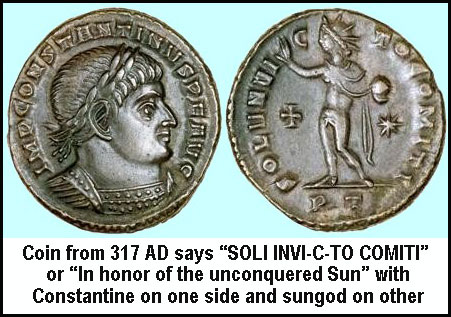
Mithraism Became Roman Catholicism
According to the Encyclopedia Britannica 11th edition vol. 18, p. 624, article "Mithras" (commentary added in parentheses), we read:
Prayers were addressed to him (Mithra) by devotees who had purified themselves by ablution (like BAPTISM by sprinkling or immersion -- Justin's First Apology, ch.61) and repeated flagellation (like PENANCE -- 1 Ki. 18:28).... It seems at first to have had relations with the cult of the Great Mother of the Gods at Rome (MARY-worship is really "Queen of Heaven" worship -- Jer. 44:17-25 & p.64, Land of Sinim by Gillespie) (like a CONVENT for women -- priestesses of Cybele were known as "Mothers" in a cult for women only), whose influence served to protect it and facilitate its growth.... From the end of the 2nd century the emperors encouraged Mithraism, because of the support which it afforded to the divine right of monarchs. (Constantine dedicated his coins to "Sol Deus Invictus"; forbade work on SUNDAY in 321 AD -- Eusebius, Life of Constantine 4:18; then endorsed Easter SUNDAY at the Council of Nicea in 325 AD) ... Its importance at Rome may be judged from the abundance of monumental remains—more than 75 pieces of sculpture (IDOLS)... Heaven and Earth ... begat Ocean, who formed with them a TRINITY corresponding to Jupiter, Juno, and Neptune. (cp. Cumont, Mysteries of Mithra, pp. 109, 111, 191) ... Tertullian speaks of "marking the forehead ... which may have been the branding of a Mithraic sign (of a celestial CROSS -- Plato's Dialogue, Timaeus; Nabarz, The Mysteries of Mithras, p.36) (similar to LENT -- Ez. 8:14) ... A sacred communion of bread (like a HOST or HOT CROSS BUNS -- Cumont, p.160; Justin's First Apology, ch. 66; Jer. 7:18), water and possibly wine, compared by the Christian apologists to the EUCHARIST, was administered to the mystic who was entering upon one of the advanced degrees ... The ceremony was probably commemorative of the banquet of Mithras and Helios before the former's ASCENSION, and its effect strength of body, wisdom, prosperity, power to resist evil, and participation in the IMMORTALITY enjoyed by the god himself.... The Mithraic priest, sacerdos or antistes, was sometimes also of the degree of PATER (Padre or Father -- cp. Matt. 23:9) ("Simon [Magus] ... was known as FATHER among the Samaritans" -- p.122, Augustus to Constantine by Robert Grant). ("Simon [Magus] ... those who follow his lead, while pretending to accept that sober Christian philosophy [2 Cor. 11:13-15] ... prostrate themselves before PICTURES and IMAGES of Simon himself and his companion ... Helen ... WORSHIPPING THEM with INCENSE [Ez. 8:11; Hos. 11:2; 2 Ki.17:11], sacrifices and libations [blood -- Ps. 16:4]. Their most secret rites ... make sport of wretched women" [SEX with temple prostitutes] -- Eusebius, Eccl. Hist. p.48) Tertullian (De praescr. haeret. 40) calls the chief priest summus PONTIFEX (bridge between God and man), probably the PATER PATRUM (Father of Fathers -- cp. Matt. 23:9), ("who always lived at ROME" -- Arendzen's Mithraism) who had general supervision of all the initiates in one city, and states that he could marry but once (Even the pope's Dagon MITER comes from Latin MITRA). According to the same author, there were Mithraic, as well as Christian, VIRGINES et conlinentes (like NUNS). Besides the administration of ("the SEVEN" -- Aiken C.F., Mithraism and Christianity, p. 380) SACRAMENTS ... the priest ... addressed prayers to the SUN AT DAWN (like EASTER SUNRISE service -- Ez. 8:16), midday and twilight, turning TOWARDS EAST, south and west respectively. ... There was pouring of libations, (Gregorian?) CHANTING and MUSIC, and BELLS and CANDLES were employed in the service. ... The most interesting aspect of Mithraism is its antagonism to Christianity. Both religions were of Oriental origin; they were propagated about the same time, and spread with equal rapidity on account of the same causes, viz. the unity of the political world and the debasement of its moral life. At the end of the 2nd century each had advanced to the farthest limits of the empire ... the struggle was the more obstinate because of the RESEMBLANCES between the two religions, which were so NUMEROUS and so CLOSE as to be the subject of remark as early as the 2nd century, and the cause of mutual recrimination. (Mithra had "TWELVE DISCIPLES" -- p. 203, Carpenter, Origins of Pagan and Christian Beliefs).The FRATERNAL (convents of "BROTHERS" -- Cumont, p.190; "Mithraism had its MONKS and NUNS, as Tertullian admits, with the TONSURE in honour of the disc of the SUN" -- Khwaja, The Sources of Christianity, p. 100; cp. Leviticus 21:5; Ezekiel 44:20) ("in sacerdotal ROBES" -- Cumont, p.166) and democratic spirit of the first communities, and their humble origin; the identification of the object of adoration with LIGHT and the SUN; the legends (in both) of the SHEPHERDS with their gifts and adoration, the FLOOD, and the ARK; the representation in art of the FIERY CHARIOT, the drawing of WATER from the ROCK; the use of BELL and CANDLE, HOLY WATER and the COMMUNION; the sanctification of SUNDAY (Justin's First Apology, ch.67) and of the 25th of DECEMBER (Birthday of the SUN; X-MAS) ("the large-scale celebration of BIRTHDAYS in Europe began with the cult of Mithras" -- Wikipedia "Birthdays"); the insistence on MORAL CONDUCT, the emphasis placed upon ABSTINENCE and SELF-CONTROL; the doctrine of HEAVEN (an initiate may "ascend into HEAVEN" -- Wright, Early History of Heaven, p. 112) and (torture of wicked in) HELL, of primitive REVELATION, of the mediation of the LOGOS emanating from the divine, the ATONING SACRIFICE, the constant warfare between GOOD and EVIL and the final triumph of the former, the IMMORTALITY of the SOUL, the LAST JUDGMENT, the RESURRECTION of the flesh and the fiery destruction of the universe—are some of the resemblances which, whether real or only apparent, enabled Mithraism to prolong its resistance to Christianity. At their root lay a common Eastern origin rather than any borrowing. (CONSTANTINE BORROWED from Mithraism) On the other hand, there were important contrasts between the two. Mithraism courted the favour of Roman paganism and combined monotheism with polytheism, while Christianity was uncompromising. The former as a consequence won large numbers of supporters who were drawn by the possibility it afforded of adopting an attractive faith which did not involve a rupture with the religion of Roman society, and consequently with the state. In the middle of the 3rd century Mithraism seemed on the verge of becoming the universal religion. (It finally did in the ROMAN CATHOLIC CHURCH)